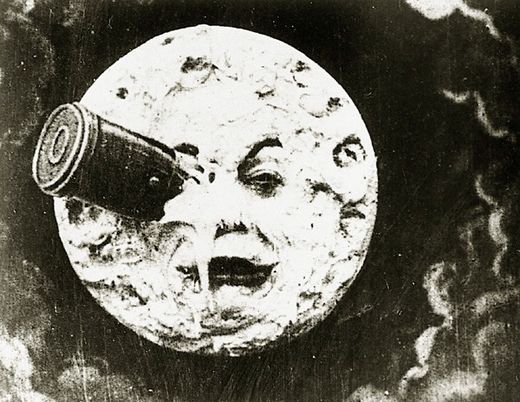
This 14 minute black and white silent film written and directed by George Melies in 1902 is the most famous of Melies’ many fantasy-themed films and is often touted as being the very first science fiction film. Towards the end of the film, animation effects were employed, thus providing one of the earliest examples of film animation as well.
It also holds the distinction of being the first pirated science fiction film, having been stolen by one of Thomas Edison’s film technicians and re-released in the United States under the title A Trip to Mars.
Melies also designed the costumes and sets, and is responsible for pioneering special effects art in some of the more than 500 films he created – most of which are now lost. Fade to black, dissolves, split screens, slow motion, stop motion, animation, double exposures, superimposition, were all developed at this time by Melies. In fact, George Melies’ experience as a professional illusionist and as a theater owner allowed him to create many of the effects we would see in his films, and he is considered to be the first special effects wizard. In fact, many of the special effects techniques used in this film hadn’t changed much over the years until the advent of CGI and were used in films such as Star Wars.
Ultimately Melies’ greatest success was also his greatest failure. He regarded the story of his films to only be a thread that would link the various special effects together once stating, “I was appealing to the spectator’s eyes alone.” The audience, while initially impressed with Melies’ work, over time became bored with the special effects overshadowing the storylines in his films. This sentiment towards his films coupled with the growing commercialization of the film industry forced Melies out of business in 1913. Eventual bankruptcy would force Melies to live out the rest of his days selling toys in a Paris subway kiosk until he eventually died penniless at the age of 77.
Filmed on a budget of 10,000 francs, the film turned out to be wildly popular. The Folies Bergere Acrobats were hired to play the Selenites, the lunar aliens. Girls from the Chatelet ballet played the assistants who helped to load the rocket into the cannon.
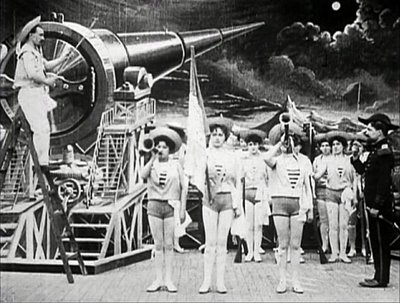 | 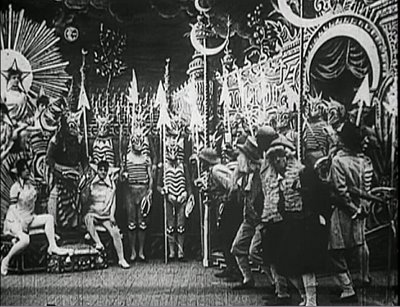 |
The screenplay was a satire, which criticized the conservative scientific community of the time, and was inspired by “The First Men in the Moon” by H.G. Wells, and “From The Earth to the Moon” by Jules Verne. In the story, The President Barbenfouillis (played by George Melies himself) proposes a voyage to the Moon to the astronomers who are members of the Astronomic Club, by illustrating his intentions of a lunar excursion on a giant blackboard. Many of the astronomers balk at the idea; disgusted the President even throws paper and books at one of the dissenters. But after overcoming their colleague’s dissent, the 5 Astronomers Nostradamus, Alcofrisbas, Omega, Micromegas, and Parafaragamus, bravely answer the call and are brought traveling suits by some female assistants.
The 5 Astronomers accompany the President to a workshop where master fabricators manufacture the rocket. After which they climb to the top of the roof of the foundry, where the cannon that will launch the rocket will be forged. A mass of molten steel is poured into the mold as chimneys off in the distance belch out smoke and fire. After construction of the rocket and cannon are completed, the Astronomers board the rocket, which is loaded into the cannon by lovely female assistants, and is fired to the Moon. At this point the world famous image of the Man in the Moon getting hit in the eye with the rocket ship makes its appearance.
After the astronomers land safely on the Moon, they emerge from the rocket and watch the Earth rise over the lunar landscape. They then lay down to sleep, having been exhausted from their journey. During their slumber, there appears a jumble of strange dreamlike imagery in the sky overhead, a comet flies by, the Big Dipper appears with a face representing each star, Saturn looks out a window from his ringed planet, the Goddess of the Moon, Phoebe, sits on a crescent moon swing, who then conjures snow that falls on the Astronomers and awakes them. Once awoken, the Astronomers seek shelter from the cold in a cave where they discover giant mushrooms. One of the astronomers opens up an umbrella, and sticks the handle into the lunar soil. The umbrella instantly transforms into a mushroom.
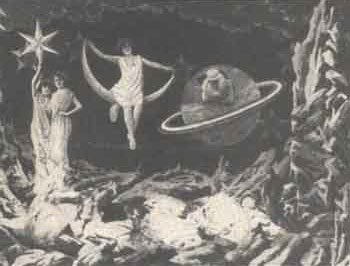
This is where the insectoid lunar aliens, the Selenites, make their appearance, emerging from beneath the lunar mushrooms. President Barbenfouillis effortlessly kills one of the Selenites who explode upon their death. More and more Selenites appear and their increasing numbers make it difficult to fend against them. The Astronomers are arrested by the Selenites and brought before their leader. Once in the Selenite Kingdom, one of the Astronomers lifts the Selenite King off his throne and throws him to the ground, killing the Selenite King and exploding him.
The Astronomers then flee amidst the chaos back to their rocket. The Astronomers enter the rocket save for one who uses a rope to tip the rocket over the edge of the Moon, which launches it back into space on its return journey to Earth. The rocket then lands safely on the Earth in the ocean, briefly submerging to the watery depths where fish and sunken ships can be seen, before rising back to the surface of the water. A ship, which tows the rocket ashore, rescues the crew and a celebratory parade is given in honor of the Astronomers and their expedition.
As with all films, A Trip to the Moon is not without its continuity errors. At one point The President accidentally knocks his own hat off. After landing on the Moon, the astronomers climb out of the rocket and watch the Earth rise, after which the rocket disappears. When the rocket first lands on the moon, it lands on an inland area, but when the Astronomers attempt to flee from the Selenites, the rocket is depicted as resting on the edge of the Moon.
In 2002, the longest known cut of the film to date was found in a French barn, which was completely hand colored and contained the final parade sequence. This cut was restored and shown at the Pordenone Silent Film Festival in 2003. The film is now considered to be in the Public Domain.
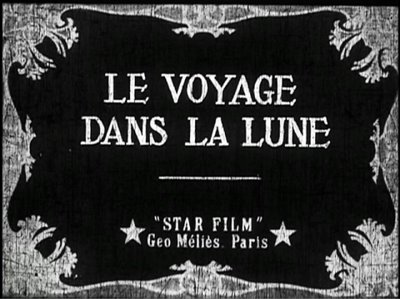
Written by Jaeson Jrakman